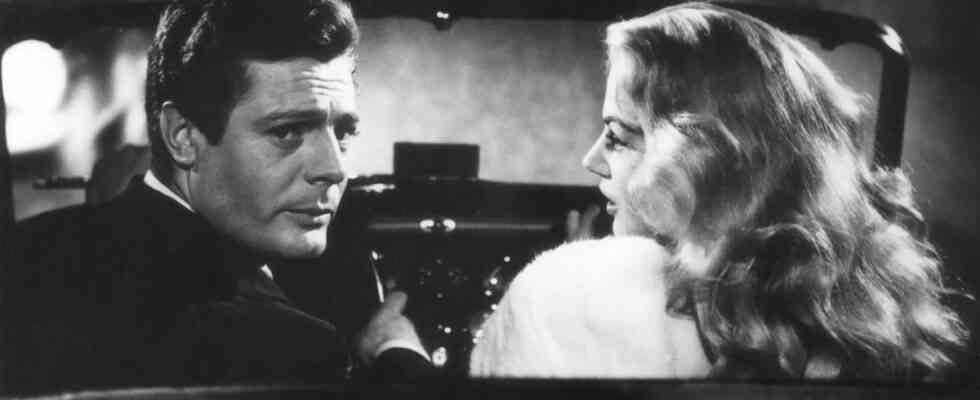Of course, a different image could have been chosen to celebrate the summer re-release in cinemas of the digitally restored 1960 version of Federico Fellini’s “La dolce vita”, one of the most glorious films of all time. Why not the most famous, which shows the gossip reporter Marcello (Mastroianni) and the film star Silvia (Anita Ekberg) in the water of the Trevi Fountain in Rome, where she lured him and where he, enraptured by her charms, followed her?
Of course, the whole scene before that, in which the giggling Ekberg with a white kitten on her head floats through the nocturnal streets to the fountain, is indescribably graceful. And yet the corresponding images have perhaps become too symbolic for the film, as they hang in what feels like every second pizzeria, like clichés of the “sweet life” in Italian: visual tourist traps of film history, the original locations of which can still be visited in Rome today.
So rather the couple in front of the Trevi scene, in Marcello’s black sports car, on their way through the Roman night, from one night’s amusement to the next, and on the run from the papparazzi (paparazzi is the name of a photographer and friend of Marcello, a name that soon after the premiere as a designation for the entire profession).
If the shot is so beautiful, it’s because it shifts the gaze. Away from Ekberg, who emancipates herself here as an icon of femininity and object of curiosity and becomes a spectator herself. Towards Marcello, whom she looks at and whose eyes have long been somewhere else. He’s the one we’re going to watch while he guides us through the film, and often: drives.
“La dolce vita” is a long tour through nightclubs and parties, but above all through the Via Veneto with its bars and cafes, the catwalk of high society. And Marcello knows them all. The club owners and their assistants. The celebrities who want to get at him for his gossip articles. The heiress he sleeps with and the prostitute whose apartment they go to. With Marcello we cross the entire social spectrum. We come to movie stars partying at night in ancient ruins, to suburban workers and peasants awaiting divine miracles, to intellectuals thirsting for a deeper meaning of existence, to a decadent aristocracy waiting only for its disappearance can live against.
Rarely has a film conveyed the feeling of showing an entire epoch from its center, its core, its innermost hot spot. Rome, this is a cosmopolitan city where everything happens, everything converges, everyone meets, a condensed universe that seems to embrace and bless the statue of Jesus attached to a helicopter and flying over the city in the opening sequence with its outstretched arms. At the same time, in 1960 we are at a high point in film history, in the golden age of modern cinema and international auteur films, with Fellini as the figurehead. Maybe that’s why the film seems to us to stand like no other for a bygone era in which cinema as the art of all arts was able to capture an entire world. A social world, but also a world of images and media.
The film already anticipates which media will soon outstrip cinema
Like other modern filmmakers, Fellini films a media regime that will soon outstrip cinema. When a huge TV convoy invades the suburb where two children pretend to have had an apparition, it’s the scurrying media people themselves who become the spectacle. Also, the film does not follow a linear narrative, but consists of a series of episodes and fast-moving phenomena that anticipate the TV program flick.
In doing so, Fellini invents a dynamic of appearance and disappearance, squinting at the next attraction that the nervous Marcello in the car may have already had his eye on. While he looks over his shoulder at us viewers who are wondering if we can still keep up. Characters, events, dialogues: everything follows one another so quickly that the sensory overload gives the impression of being “too late”. As if Ekberg were no longer sitting next to him in the car, as if she were just a fading memory, while his attention has long been elsewhere.
Marcello’s search – for happiness, love, the right woman, the meaning of life – goes nowhere. So much so that ultimately the quest itself vanishes, leaving only desperate excess. “Can’t one just live in the enchanted order of a finished work of art?” asks Marcello’s intellectual friend Steiner (Alain Cuny). This accomplished work of art is “La dolce vita” all the more because the void gapes beneath its enchanted, lively, chaotic order: the dance of the sweet life is a dance on a volcano.
La dolce vita, Italy / France 1960. – Director: Federico Fellini. Book: Fellini, Ennio Flaiano, Tullio Pinelli, Brunello Rondi. Camera: Otello Martelli. Starring Marcello Mastroianni, Anita Ekberg, Anouk Aimée, Yvonne Furneaux. Studiocanal, 167 min. Rerun in cinemas: July 14, 2022.

